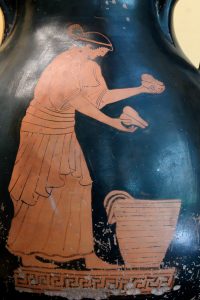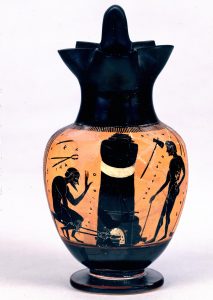Household Production
John-Michael Bout
What does it mean when you cannot go to the mall? It is hard to imagine life without the ease of amenities and shopping centers. Yet Greeks from the Classical period (5th-4th centuries BCE) thrived in a world like this. There is a common misconception of household production in ancient Greece that visualizes a family creating all their own goods on a small farm and only trading for a few items with locals. This raises a fundamental question about the Greek household (oikos): How self-sufficient was the oikos in reality?

To begin answering this question, it is important to first understand what ‘household production’ even means. The International Encyclopedia of the Social & Behavioral Sciences offers this helpful definition: “Household production is the production of goods and services by the members of a household, for their own consumption, using their own capital and their own unpaid labor.” Recent scholarship has debated how self-sufficient the Greek house really was, but before the 1990s, many scholars assumed that every house produced all its own necessary goods and services for survival. This assumption is due to biases and ideals found in the primary sources that survive from Athens. The ancient writer and commander Xenophon wrote in his informative work Oeconomicus 5.1 that an Athenian male citizen’s ideal mode of employment was to be a gentleman farmer. Plato also puts this image forward in his book the Republic 3.370c onwards as the ideal employment for Athenian men. If Xenophon and Plato agree, it must be true. And with that, the debate was closed for many years. This ideal household image, however, was founded on just that, an ideal.
Early debate around ancient household production focused on whether the economy was “primitive” or “modern.” Most thought the economy was clearly primitive. Yet, defining any economy as either “primitive” or “modern” is an unhelpful dichotomy to draw and does not lead to a nuanced, evidence-based conclusion. Moses Finley, in 1973, advocated for a very independent and isolated oikos, and his influence has been pervasive ever since. Finley further argued that lay Greeks only took on economic activities necessary for providing sustenance to themselves and their families, and prioritized farming a plot of land and producing most, if not all, necessary goods themselves. He interpreted Classical Athens as just a large group of net consumers rather than producers and expected most city dwellers to travel outside the walls to open lands to farm. This general approach takes the idealistic philosophies put forward by Xenophon and Plato at face value and ignores the fact that Athenians may have had contradictory attitudes towards their home activities.
Contemporary scholars, such as Bradley Ault, are challenging this approach based on thorough archaeological work being done at Athens and Olynthos. Ault pushes back on a simple view of the oikos and argues that this conclusion comes from a lack of considering texts other than the philosophers and an altogether dismissal of archaeology in the discussion. On top of this, some of the same primary sources that Finley draws from also make mention of citizens busy with work other than farming.

In reality, individual homes had a lot of flexibility to be either self-sufficient with farming and producing their own goods, or more often, to rely heavily on trade in the agora and private shops. They certainly did not have the convenience of modern malls, but that is a far cry from every home being economically independent. Current scholarship interpreting evidence in Athens and Olynthos points towards an interconnected city and a thriving market community. Ault discusses how the evidence of coinage around the agora and the higher housing prices in trade sectors point towards the higher value of the plots of land near market spaces. Further, artifacts and implements have been discovered in and around Athens that originate from all over the Mediterranean, indicating a high level of trade.
Outside this modern debate, it is worth noting that there is very little noticeable difference between buildings where people worked and lived. In most of the references, there is no indication of urban production being done in another space separate from the oikos. While this reality makes archaeological interpretation challenging, it emphasizes the interconnected nature of the simple Greek home to the whole of the city. Ault sums this up nicely when he says, “Clearly the entrepreneurial spirit was alive and well in the Greek polis.”[1]
How Green Were the Greeks?
The last decade has shown a surge in green approaches to energy consumption and general production. One of the byproducts of this societal trend has been a rise in household production. Secondhand thrifting, mending torn clothes, and growing fresh produce are all common ways to live a “green-life.” But how green were the Greeks? While the Greeks’ motivation driving household management and frugality may be different from our societies’ more global goals, it is interesting how many activities are now shared over two thousand years later. In book 7.6-40 of Oeconomicus, Xenophon writes about the dialogue between Socrates and Ischomachus. They discuss how to train men and women alike to be effective in household management and practical tasks. The Greeks cared about consumption and general production through the lens of frugality, whereas the modern trend considers general consumption and production through the lens of global warming and overpopulation. How green were the Greeks? They were green, not from a moral standpoint, but from an economic outlook.

So what kinds of activities were common to a Greek household? Archaeological and literary evidence demonstrates a wide variety of activities such as textile production, animal husbandry, pottery, olive oil pressing, farming, food preparation, stonemasonry, sculpting, cobbling, metalworking, baking, large-scale weaving, and furnace work (shown in the image to the right). As this extensive list demonstrates, the production opportunities in classical Greece were nearly as varied as today. Several of these topics are explored further in chapters 8-10. This list only scratches the surface of the entrepreneurial opportunities available to the Greek household.
In sum, the oikoi of Classical Athens were able to specialize in one form of manufacture or another based on a high level of trade in and out of the city. Instead of Finley’s independent household, the Greeks had a highly interconnected understanding of household production even though the marketplace was not nearly as polished as a modern mall. How self-sufficient was the oikos in reality? There was no need that the oikos be entirely self-sufficient at all.
Bibliography and Further Reading
- Ault, A. B. 2000. “Living in the Classical Polis: The Greek House as Microcosm.” Classical World 93: 483-496.
- -. 2007. “Oikos and Oikonomia: Greek houses, households and the domestic economy.” In BUILDING COMMUNITIES: House, Settlement and Society in the Aegean and Beyond edited by R. Westgate, N.R.E Fisher and J. Whitley, 259-265. London: British School at Athens.
- Finley, M. I. 1973. The Ancient Economy. Berkeley: University of California Press.
- Morgan, J. 2010. The Classical Greek House. Exeter: Bristol Phoenix Press.
- Ault 2007. ↵

